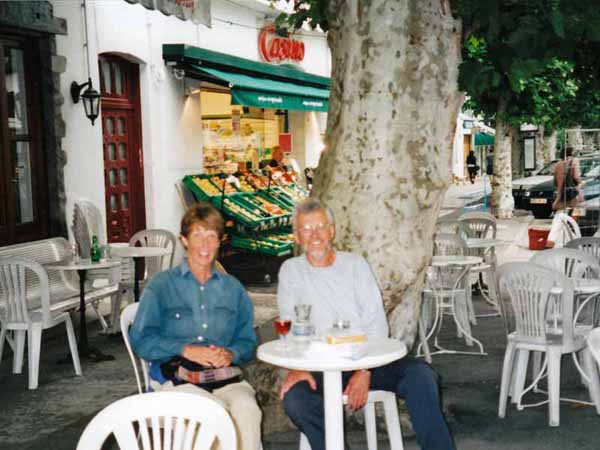Monday, 16 June 2003
Distance 27 km
Duration 5 hours 55 minutes
Ascent 450 m, descent 523 m
Map 69 of the TOP100 blue series (now superseded)
Topoguide (ref. 653) Sentier de Saint-Jacques de-Compostelle, Moissac/Condom/Roncevaux
We set off at 6:40, via the moat and the bridge. The river here, the Gave d’Oloron, is a fine swirling torrent coming out of the Pyrenees, and as we crossed it, we went from the ancient province of Béarn to the country of the Basques.

Past the little town of Castetnau-Camblong we plunged into a wood on a thickly overgrown track. Every few minutes the silence was shattered by a shotgun blast from somewhere near.
There were signs warning that pigeon shooters could be a hazard to people passing by, which was not confidence-inspiring. That combined with the wild zig-zags of the track persuaded us to take a short cut on the road.
The designers of GRs get carried away sometimes with keeping people away from roads, however small.

Just past the restored chateau of Montgaston, as we reached the D23, the path led us through a farmer’s yard, where a sheltered seat and a water tap had been set up for pilgrims.
It was a kind gesture but we were inclined to be ungrateful after the coffee and cake of Uzan.
We emerged through a garden gate onto the highway, and, immediately after the bridge, left it again for the short walk to Aroue.

This was when we felt we had really arrived in Basque land. The street signs were suddenly in both French and Basque and the heavy Béarnaise houses, with their half-gable, half-hip rooflines, gave way to white facades ornamented with dark red latticework.
We sat on a wall in the shade of the church for a snack and saw a brilliant short-cut on the map, straight from here to Saint-Palais, along the road. The GR meanwhile was thrashing about like an injured snake.
In the event it was a rather unpleasant walk. The air was hot and heavy and there was more traffic than we had bargained for. As the roadside was a tangle of nettles and blackberries, we were almost under the wheels of passing vehicles. But at the top of a rise, at Domezaine, an unexpected pleasure awaited – the cheerful umbrellas of a hotel.
Our Flemish friends were waving from the terrace, having discovered the same short-cut as us. The bar was full of old men in berets returning from a funeral, drinking the bitter liqueur of the region known as Suze. To our disappointment, they spoke a form of French, not Basque.

After this reviving coffee break, we made short work of the last five km into Saint-Palais.
Even before we crossed the bridge into town, we saw a sign to the camping ground, but a morgue-like stillness enveloped the place when we got there. Leaves from last autumn lay in drifts and everything was locked. It was time to consult the Office of Tourism.
A footbridge took us into the centre and at the Office of Tourism we asked about accommodation.

We found out there was a gîte, run by Franciscans, which sounded alarmingly religious. We had no wish to join hands and sing the Pilgrim’s Hymn again.
The woman also said that the camping ground was open, an assertion that we were able to contradict, whereupon there was a startled silence. She made a phone call and suggested that we try again in two hours.
The 15th of June is the day when all municipal camping grounds in France must be open, and it was the 16th.
After lunch in the church graveyard, we retired to a cafe for a drink, then strolled back over the footbridge.

The camping ground was a scene of frenzied activity. Women with mops were working in the shower block, a ride-on mower was charging to and fro, someone was sweeping the paths and a team of men were planting flowers in tubs.
On top of that we got a 10% discount. We hung our washing out as usual, but the air was so humid that it did not dry, even hanging in the sun and wind.
Saint-Palais (known in Basque as Donapaleu) had a brief moment of glory in the 16th century as the capital of Navarre, when the Spanish part of the kingdom was lost, but now it is a modest market town.
In the evening we had three restaurants to choose from in the Place du Forail. By that time it had suddenly turned cold, so we ate indoors at the Hotel du Midi.
The entrée was an elaborate salad, then I had Poulet Basquaise, the local dish, and Keith had steak with Roquefort sauce.
As is our custom, we cleaned every particle from our plates.
Previous section: Aire-sur-l’Adour to Navarrenx